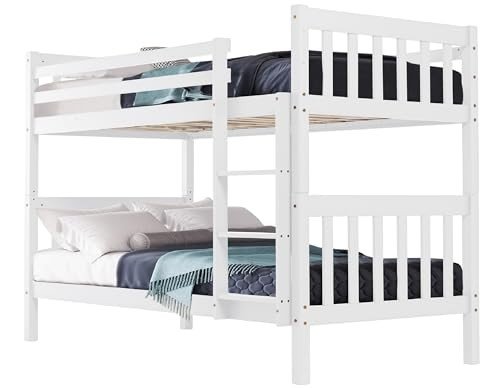The 10 Scariest Things About Bunk Beds Children's
The Ultimate Guide to Bunk Beds for Children: Safety, Styles, and Benefits
When it pertains to styling a kid's room, moms and dads frequently deal with the dual difficulty of maximizing space while making sure comfort and performance. Bunk beds have actually become a popular service that attends to these needs, providing not just sleeping arrangements however also contributing to a space's aesthetic. In this thorough guide, we will dig into different aspects of kids's bunk beds, concentrating on their advantages, security functions, styles, and considerations for moms and dads considering this purchase.
Table of Contents
- Benefits of Bunk Beds
- Safety Features to Consider
- Types of Bunk Beds
- Design and Style Options
- Maintenance Tips
- Frequently Asked Questions (FAQs)
1. Advantages of Bunk Beds
Bunk beds use numerous advantages for kids and their moms and dads. Here are some essential benefits:
Space-Efficiency: Bunk beds are an exceptional option for smaller sized rooms. By stacking one bed on top of another, more flooring space is readily available for play, storage, or research study areas.
Cost-efficient: When children share spaces, bunk beds can decrease the requirement for buying two separate beds, thus saving money.
Fosters Social Interaction: Bunk beds can assist brother or sisters or buddies bond by sharing a space, creating opportunities for social development.
Enjoyable Factor: The idea of sleeping “up high” adds a playful aspect to bedtime, making the shift to sleeping alone simpler for some children.
Versatile Design: Bunk beds are available in various designs, colors, and designs to match any space style, enabling for customization that shows the child's character.
2. Safety Features to Consider
Security is paramount when it comes to kids's furnishings, especially in the case of bunk beds. Here are some vital security functions to examine:
Safety Feature
Description
Sturdy Construction
Frames made of strong wood or metal are chosen.
Guardrails
Must be at least 5 inches high and extend along both sides of the upper bunk.
Ladder Design
Make sure ladders are safely attached and have non-slip steps.
Bed mattress Size & & Fit
Should fit snugly within the frame to avoid gaps.
Weight Limit
Always stick to the maker's weight limit recommendations.
3. Types of Bunk Beds
Bunk beds are available in several designs, accommodating different requirements, preferences, and space sizes. Here are some common types:
Standard Bunk Bed: The a lot of fundamental type, with one bed on top of another.
Loft Bed: Features a high upper bed with space underneath for a desk or play area.
Futon Bunk Bed: Combines a top bunk with a futon on the bottom, supplying flexibility for seating and sleeping.
L-Shaped Bunk Bed: This style has the leading bunk set at a perpendicular angle to the bottom, creating a small corner area.
Triple Bunk Bed: Accommodates three kids utilizing stacked beds, suitable for large families or pajama parties.
4. Style and Style Options
When it comes to choosing a style for children's bunk beds, the options are practically limitless. Here are some popular designs:
Traditional Style: Often made of wood, these bunk beds feature ornate details and are ideal for classic or rustic-themed spaces.
Modern Style: Characterized by clean lines and minimalist styles, contemporary bunk beds can be made of metal or wood.
Themed Bunk Beds: Some brand names offer bunk beds formed like castles, automobiles, or play houses, making bedtime less of a task.
Convertible Bunk Beds: These can be separated into two private beds, offering flexibility as children grow.
Colorful Options: Bunk beds in vibrant colors can add a sense of delight and playfulness to any room.
5. Maintenance Tips
Maintaining a bunk bed is essential for longevity and safety. Here are some ideas:
Regular Inspections: Check for loose screws or bolts every couple of months and tighten them as required.
Cleaning: Wipe down frames regularly to avoid dust accumulation; consider using a vacuum for hard-to-reach areas.
Mattress Care: Rotate mattresses regularly and use protective covers to prolong their life.
Look for Wear and Tear: Look for any indications of damage in the wood or metal and consider changing parts if essential.
Teach Kids Safety Rules: Encourage kids to use ladders properly and guarantee they comprehend the security functions of their bed.
6. Regularly Asked Questions (FAQs)
Q1: What age is appropriate for oversleeping a top bunk?
A1: Typically, children aged 6 and older are recommended for upper bunk sleeping, as they have the necessary motor skills to climb up securely.
Q2: Do bunk beds feature a mattress?
A2: Most bunk beds are sold as frames only, so you will need to purchase mattresses independently. Ensure that the mattress fits the frame snugly.
Q3: Can bunk beds be separated later on?
A3: Many styles permit conversion into two private beds, providing flexibility for future needs.
Q4: How can I guarantee my child's safety on a bunk bed?
A4: Comply with safety requirements and guarantee guardrails, a sturdy frame, and a secured ladder are in location.
Q5: Are there weight limitations on bunk beds?
A5: Yes, always inspect the producer's requirements regarding weight limits to guarantee safety.
Bunk beds for children can serve multiple functions while making sure safety and style. With varied Adult Bunk Bed hongzumwalt.top and models readily available on the market, moms and dads can find a system that not only optimizes bedroom space but likewise reflects their child's unique tastes. As with any furnishings, understanding safety functions, upkeep, and how they fit into a kid's way of life will make sure that these beds remain a useful furnishings option for several years to come.
Through cautious factor to consider and adherence to security guidelines, bunk beds can offer a long-lasting, enjoyable, and functional sleeping option that children love.
